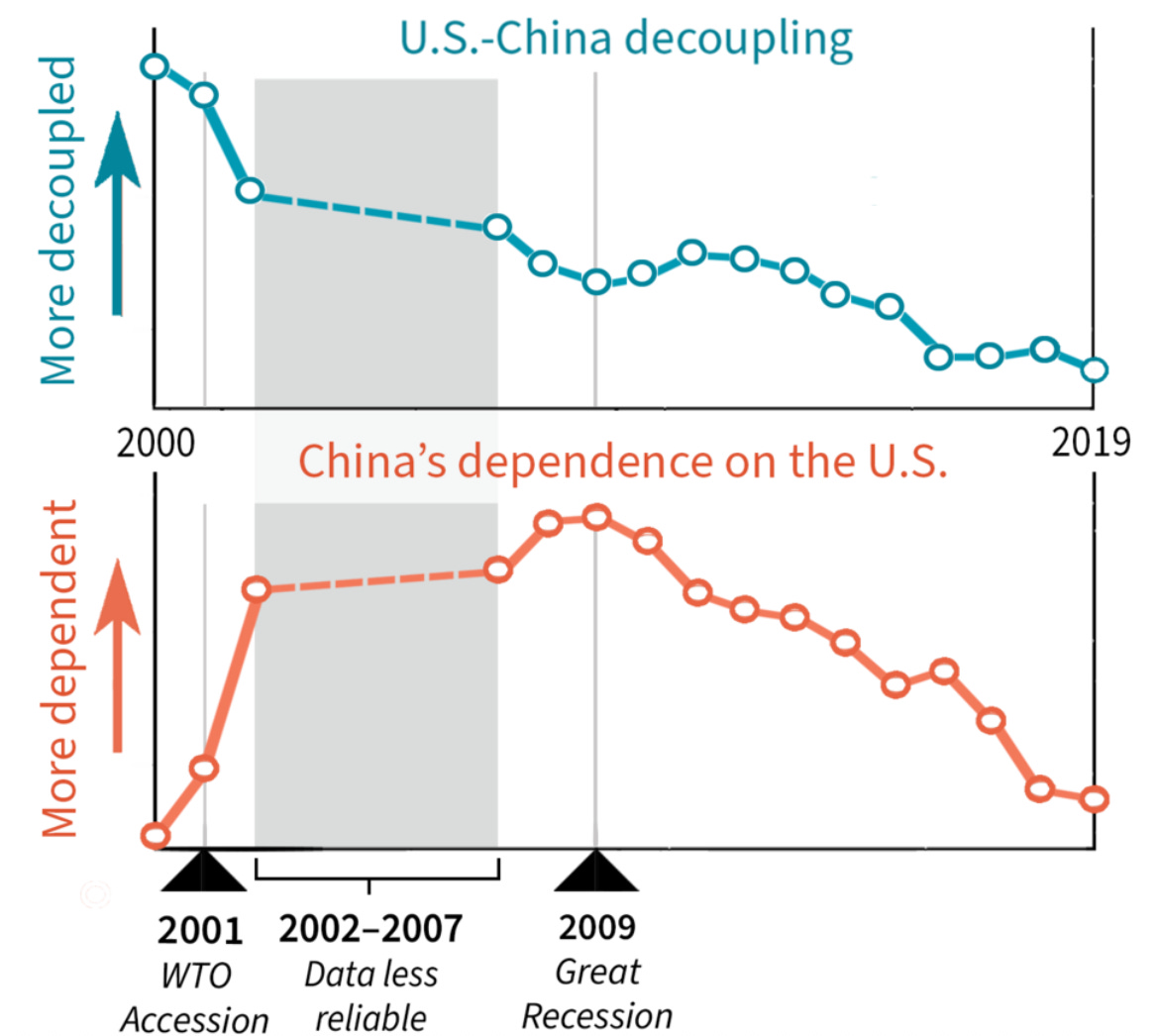Mapping U.S.-China Technology Decoupling and Dependence
Charting two decades of trends and the current state of technology interdependence and decoupling between the U.S. and China
INSIGHTS
With globalization, U.S-China technology decoupling has been declining steadily since 2000, the year before China acceded to the World Trade Organization.
China’s technological dependence on the U.S. peaked in 2009 at the end of the Great Recession.
Newer technology fields generally exhibit both more decoupling and a steeper drop in China’s dependence on the U.S.
However, greater decoupling in a field is followed by more dependence of China on the U.S. after a few years, suggesting a tension between China’s desire and its ability to progress independently.
Source Publication: Pengfei Han, Wei Jiang, and Danqing Mei (2022). Mapping U.S.-China Technology Decoupling, Innovation, and Firm Performance. Social Science Research Network (SSRN) working paper.
The U.S. and China have recently sought to unwind the current level of technology integration and interdependence between the two countries. This process of diverging into two technology ecosystems with an increasing degree of separation is now widely known as “decoupling.” The extent of decoupling may also have implications for China's technological dependence on the U.S. While there have been many debates among scholars and policymakers about the extent and implications of technology decoupling, there has not been a comprehensive study mapping the current state of technology decoupling and levels of dependence between the two countries. Have the U.S. and China become increasingly decoupled? Can China achieve technology independence via decoupling?
The data. To answer these questions, researchers developed measures for technology decoupling and dependence based on records from the U.S. Patent and Trademark Office and the Chinese National Intellectual Property Administration.
Researchers measured decoupling by establishing how often patents in one country cite their own patents compared to citing patents of the other country. If one country, for instance, cites no patents of the other, the two are in a state of “complete decoupling.” By contrast, when one country is just as likely to cite patents of the other country as they are to cite their own, the two nations are in “complete integration.” This measure of decoupling seeks to capture how a country formulates or applies different technological standards and advances along different technological trajectories.
Researchers measured dependence by establishing how often U.S. patents cite China’s patents compared to how often China’s patents cite U.S. patents. If China’s patents cite U.S. patents with greater frequency than vice versa, China is understood to be more dependent on U.S. technology. High dependence is usually associated with a weaker competitive position.
The two concepts of decoupling and dependence are separate and not directly correlated. Countries can be integrated and dependent, or integrated and independent. For instance, the U.S. has historically not been dependent on China’s technology in the same way that China has been on U.S. technology, even as their integration has grown.
Researchers placed particular focus on patents in 10 high-tech fields: smartphones, semiconductors, software, pharmaceuticals, internal combustion engines, machine learning, neural networks, drones, cloud computing, and self-driving cars.
More integration than decoupling. In 2000, the U.S. and China were far more decoupled than they are today. At that time, domestic patents in either country cited relatively few patents in the other because each had a technology ecosystem largely separate from the other. The two ecosystems began to integrate further as China joined the World Trade Organization in 2001, and the overall trend toward integration has continued since then. This phenomenon can be seen in the development of smartphones — early versions used exclusively U.S. technology, but today’s versions combine technology from both countries’ ecosystems.
Researchers noted signs of increasing decoupling beginning in 2018, possibly associated with trade barriers launched by both governments, but found the sample period too short to draw definitive inferences.
U.S.-China decoupling and dependence 2000–2019
China’s reduced dependence since 2009. The technologies of U.S. and China continued to become more integrated since 2000, conforming to the general trend of globalization. China’s technological dependence on the U.S., however, is hump-shaped: it rose throughout the decade approaching the Great Recession, peaked in 2009, and then began to decline as China developed its own R&D and innovative capacity. For example, China’s widely-used mobile payment platforms like Alipay or WeChat Pay do not depend heavily on U.S. mobile payment technology.
Among the 10 high-tech fields analyzed, China’s dependence on the U.S. is the greatest in pharmaceuticals, semiconductors, software, and smartphones, but their dependence levels decreased over time. Most of the more decoupled fields are relatively new technologies, such as neural networks, cloud computing, and self-driving cars. These newer fields exhibit more decoupling and a steeper drop in China’s dependence on the U.S. Particularly worth noting is the “drones” sector, whose dependence measure turned negative — i.e., China took the lead in 2019.
Dependence: older vs. newer technology fields
For China, decoupling gives rise to dependence. While overall levels of China’s technology dependence on the U.S. are declining, researchers uncovered evidence of a nuanced feedback loop: a lower level of China’s dependence on the U.S. in a given technology field predicted a higher level of decoupling in the coming year. However, a higher level of decoupling predicted a higher level of dependence two years down the road.
What can account for these findings? The research suggests that as China underwent economic expansion, its technology advancement relied heavily on adopting foreign, cutting-edge technologies, in particular that of the United States. After a wave of learning and adoption, however, China’s technology dependence on the U.S. declined, as stronger domestic capabilities enabled a higher level of technology decoupling with the U.S. Yet, decoupling creates a barrier for Chinese companies to learn from their foreign counterparts, which hinders further progress and puts China at a disadvantage when more advanced technologies are developed. Such a zigzag process suggests a tension between China’s desire and its ability to progress independently and may explain its growing integration with the rest of the world despite mutual distrust.



